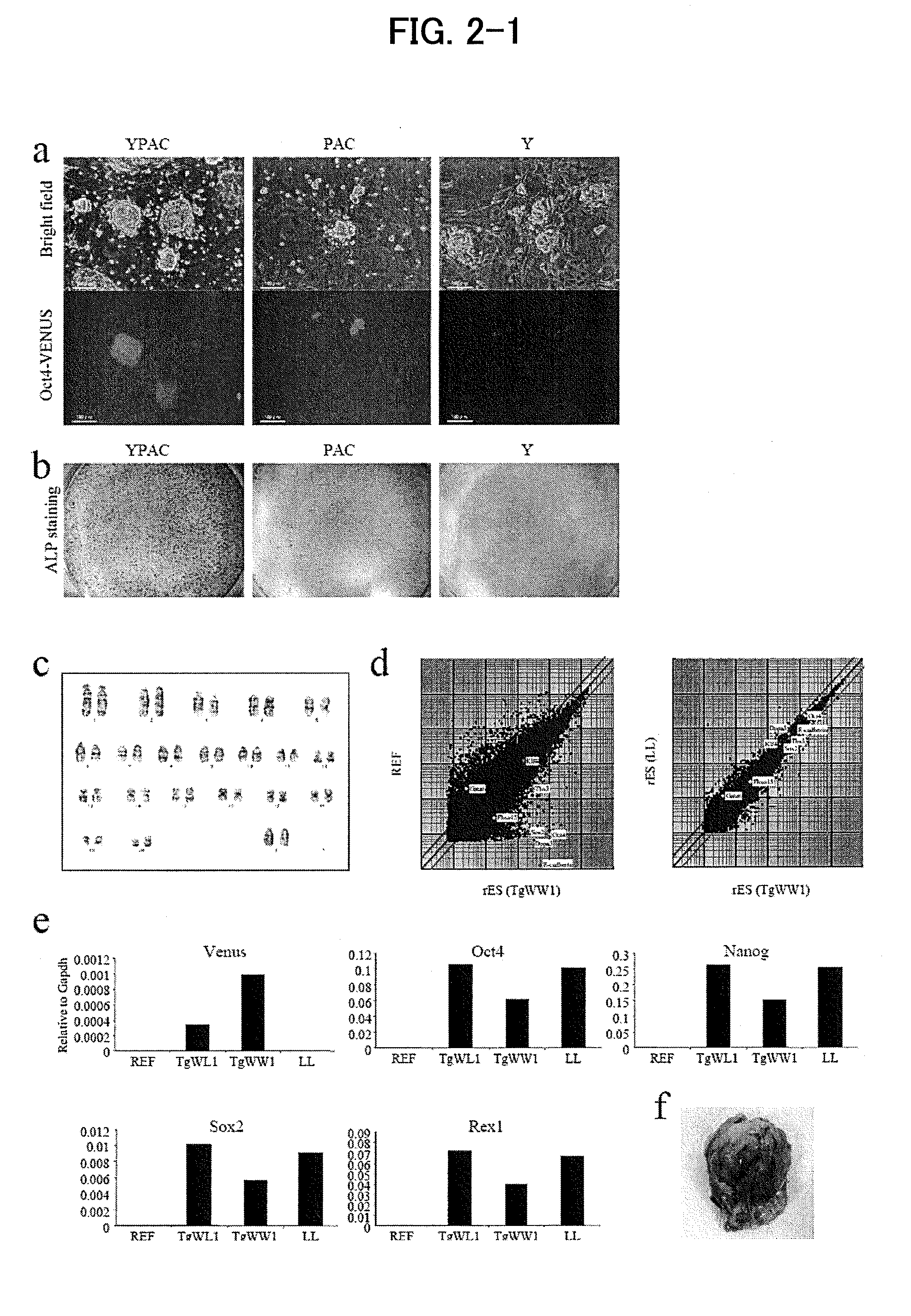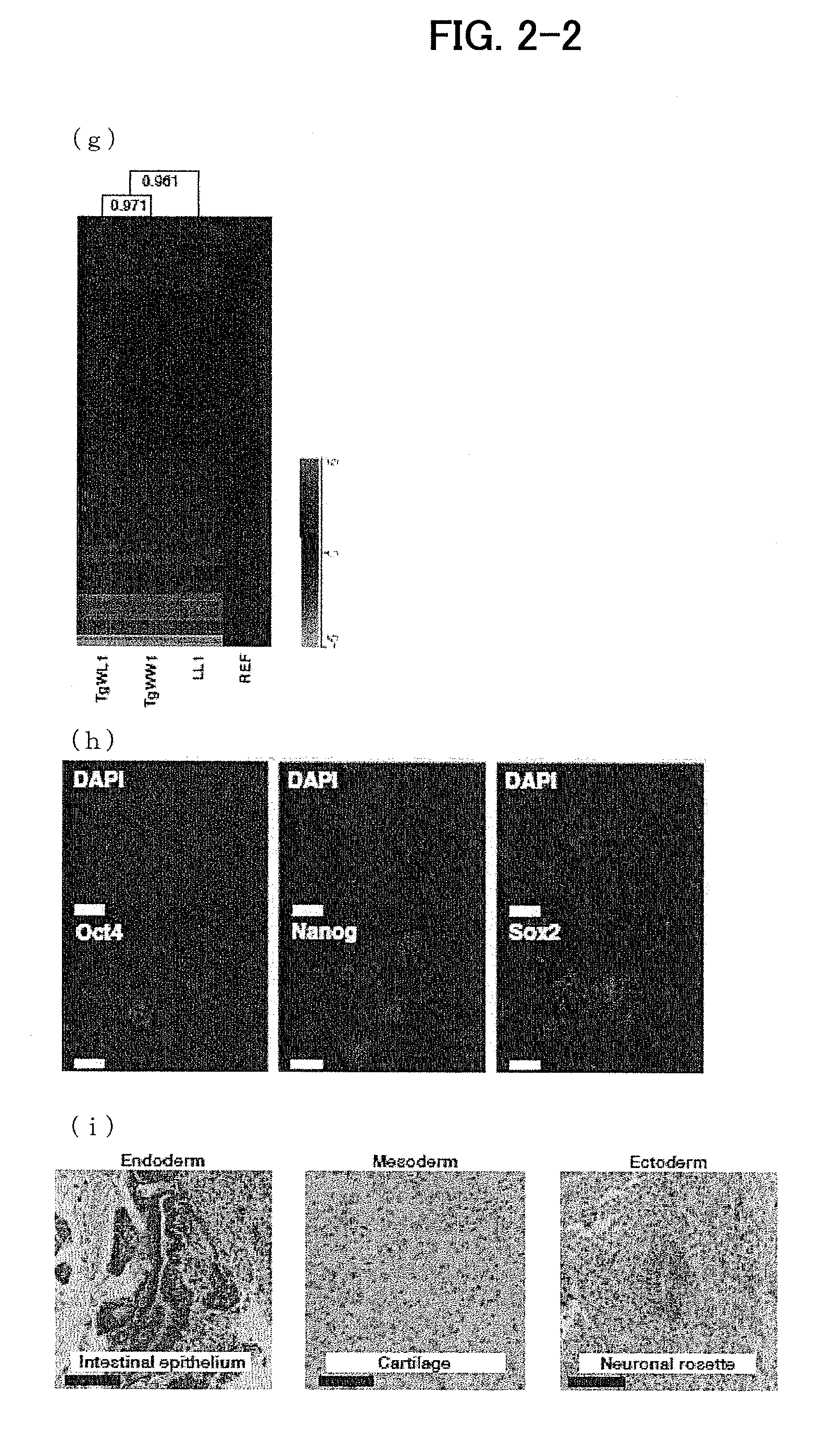Method for constructing chimeric rat using rat embryonic stem cells
- Summary
- Abstract
- Description
- Claims
- Application Information
AI Technical Summary
Benefits of technology
Problems solved by technology
Method used
Image
Examples
example 1
Preparation of Fluorescence Reporter Transgenic Rats
[0173]To establish and verify ES cells, a transgenic rat was prepared for monitoring the expression of the Oct4 gene by fluorescence. The Oct4 promoter region DNA was amplified from Wistar rat genomic DNA by a PCR using KOD Ver. 2 DNA polymerase (Toyobo), and inserted into the pCS2-Venus plasmid. The Oct4 promoter-Venus DNA was injected into the pronucleus of a fertilized egg of a Wistar rat to obtain an Oct4-VENUS transgenic rat.
example 2
Preparation of Rat ES Cells
(1) Preparation of Reagents and Feeder Cells
[0174]First, 4 kinds of inhibitors, i.e., Y-27632, a ROCK inhibitor (WAKO Company), PD0325901, an MEK inhibitor (Axon Medchem Company), A-83-01, a type I TGF-(3 receptor inhibitor (TOCRIS Company), and CHIR99021, a GSK3 inhibitor (Axon Medchem Company), were prepared (hereinafter, these 4 kinds of inhibitors are referred to as “the YPAC factors”).
[0175]The basal medium for ES cells was prepared by adding 20% FBS for ES cells (Lot No. 1204059: GIBCO Company), 0.1 mM 2-Mercaptoethanol (Sigma Company), 1% Non Essential Amino Acid Stock (GIBCO Company), and 1% lxAntibiotic antimycotic (GIBCO Company) to a DMEM (GIBCO Company) containing 110 mg / L Sodium Pyruvate and 200 mM GlutaMax.
[0176]The YPAC factors were added to this basal medium for ES cells to obtain concentrations of 10 μM for the ROCK inhibitor Y-27632, 10 μM for the MEK inhibitor PD0325901, 0.5 μM for the type I TGF-β receptor inhibitor A-83-01, and 3 μM fo...
example 3
Verification of Rat ES Cells
[0180]Verification was performed for the rat ES cells obtained in Example 2 and the process of their preparation.
(1) Outgrowths of Inner Cell Masses (ICMs) in the YPAC Culture Medium
[0181]Using inner cell masses (ICMs) from blastocysts of the transgenic rat prepared in Example 1, an investigation was performed with and without addition of the YPAC factors to the basal medium for ES cells of Example 2. In the absence of the YPAC factors, Oct4-Venus fluorescence was detected 3 days after plate seeding; 7 days later; however, a dome-like growth similar to a mouse ES colony appeared but then disappeared. In the presence of the YPAC factors, the ICM cells grew rapidly while maintaining the Oct4-Venus fluorescence even 7 days later (FIGS. 1a and b). The gene expression of the pluripotency factors Oct4, Nanog, Sox2, and Rex1 was examined by quantitative PCR; higher levels were found with addition of the YPAC factors than in the absence of the YPAC factors. In th...
PUM
| Property | Measurement | Unit |
|---|---|---|
| Mass | aaaaa | aaaaa |
| Fraction | aaaaa | aaaaa |
| Fraction | aaaaa | aaaaa |
Abstract
Description
Claims
Application Information
 Login to View More
Login to View More - R&D Engineer
- R&D Manager
- IP Professional
- Industry Leading Data Capabilities
- Powerful AI technology
- Patent DNA Extraction
Browse by: Latest US Patents, China's latest patents, Technical Efficacy Thesaurus, Application Domain, Technology Topic, Popular Technical Reports.
© 2024 PatSnap. All rights reserved.Legal|Privacy policy|Modern Slavery Act Transparency Statement|Sitemap|About US| Contact US: help@patsnap.com










